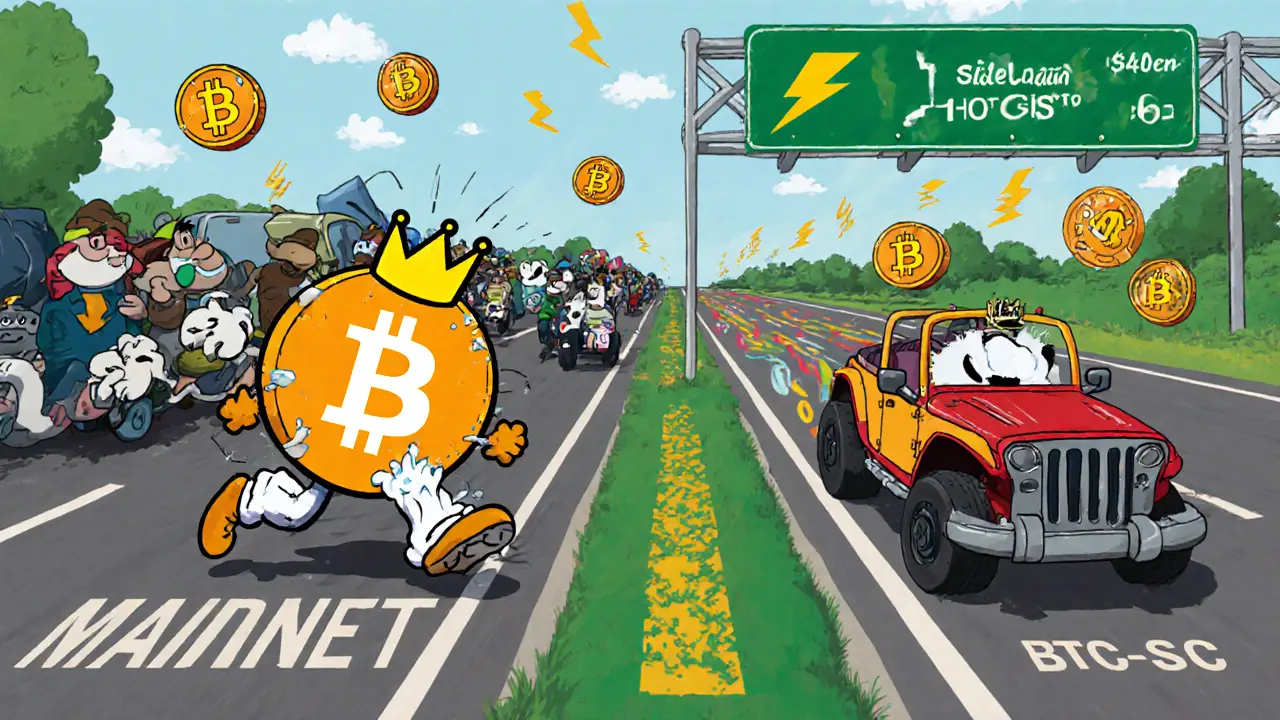What Are Sidechains in Cryptocurrency? A Simple Guide to Scalable Blockchain Networks
 Nov, 6 2025
Nov, 6 2025
Sidechain Fee Calculator
Compare Mainchain vs Sidechain Transactions
See how sidechains dramatically reduce fees and increase speed for cryptocurrency transactions. Input your values to see the cost savings.
When Bitcoin or Ethereum gets slow and expensive to use, you don’t have to wait for the main network to change. That’s where sidechains come in. They’re separate blockchains that connect to the main one-letting you move assets back and forth without breaking security or slowing down the original network. Think of them like dedicated lanes on a highway: same road, but less traffic, faster trips, and room to test new features without clogging the main route.
How Sidechains Work: The Two-Way Peg
At the heart of every sidechain is something called a two-way peg. It’s the system that lets you lock coins on the main blockchain and unlock equivalent tokens on the sidechain-and vice versa. Here’s how it works in practice:
- You want to move 1 BTC from Bitcoin to a sidechain? You send it to a special lockbox address on the Bitcoin network. Once confirmed, those coins are frozen and can’t be spent again on Bitcoin.
- After a short waiting period (to prevent fraud), the sidechain releases 1 equivalent token-let’s call it BTC-SC-onto its own network.
- Now you can use BTC-SC on the sidechain: send it fast, pay low fees, run smart contracts-even if Bitcoin itself can’t do that.
- When you’re done, you send BTC-SC back to a burn address on the sidechain. That destroys the tokens, and the original 1 BTC gets unlocked on Bitcoin.
This system keeps things secure. If the sidechain gets hacked, only the sidechain tokens are at risk. Your Bitcoin stays safe on the main chain. No one can double-spend or fake the transfer because the lockbox and burn addresses are publicly verifiable.
Why Sidechains Matter: Speed, Cost, and Flexibility
Main blockchains like Bitcoin and Ethereum were never built to handle millions of daily transactions. They’re slow, expensive, and rigid. Sidechains fix that by offloading work.
On a sidechain, transactions can cost just a few satoshis-far less than the $5-$20 fees you might pay on Ethereum during peak times. Confirmations happen in seconds, not minutes. Some sidechains process hundreds of transactions per second, while Bitcoin manages only 7.
But it’s not just about speed. Sidechains let you add features the main chain doesn’t support. Bitcoin, for example, doesn’t natively run smart contracts. That’s where Rootstock (RSK) comes in. It’s a Bitcoin sidechain that brings Ethereum-like smart contract functionality to Bitcoin users-without changing Bitcoin’s code.
Another example is Liquid Network, also a Bitcoin sidechain. It’s used by exchanges and institutions for faster, private settlements. Instead of waiting 10 minutes for a Bitcoin confirmation, Liquid settles in under two minutes. That’s huge for trading platforms.
Sidechains vs. Other Scaling Solutions
People often confuse sidechains with layer-2 solutions like the Lightning Network or rollups. Here’s the difference:
- Lightning Network is a payment channel built on top of Bitcoin. It doesn’t have its own blockchain-it’s a nested system that relies on Bitcoin’s security.
- Rollups (like zkSync or Optimism) bundle many transactions into one on Ethereum and post them back to the main chain. They’re still tied tightly to Ethereum’s rules.
- Sidechains are full blockchains with their own consensus, rules, and validators. They’re independent but connected.
This independence is both a strength and a risk. Sidechains can innovate faster-developers can test new consensus algorithms, token standards, or privacy features without asking the whole Bitcoin community for approval. But they also need their own security. If a sidechain’s validators are compromised, users could lose funds on that chain. That’s why trusted sidechains like Liquid and RSK use federated or proof-of-stake models with strong oversight.

Real-World Use Cases
Sidechains aren’t just theory-they’re already in use:
- Rootstock (RSK): Enables smart contracts on Bitcoin. Developers build DeFi apps, NFTs, and DAOs using Bitcoin’s security without touching Bitcoin’s core protocol.
- Liquid Network: Used by Bitfinex, Kraken, and other exchanges for instant, confidential asset transfers between institutions.
- Polygon PoS: Though often called a layer-2, Polygon’s sidechain model lets Ethereum dApps run with near-zero fees and instant finality.
- Komodo: Lets developers launch their own sidechains with customizable security and consensus rules. Useful for private enterprise blockchains.
These aren’t experiments. They’re production-grade tools used daily by traders, developers, and institutions. Liquid Network processes over $10 billion in monthly volume. RSK has over 100 active dApps.
Who Uses Sidechains and Why
Sidechains serve different users in different ways:
- Traders and exchanges use them for fast, low-cost settlements. No more waiting for blockchain confirmations during volatile markets.
- Developers use them to build and test new apps. Launching a DeFi protocol on a sidechain costs pennies. On Ethereum mainnet? Thousands.
- Enterprises use private sidechains to handle internal transactions, supply chain tracking, or digital identity-without exposing data to public blockchains.
- Bitcoin holders who want smart contracts or DeFi access can use RSK without selling their BTC.
Sidechains give you options. You don’t have to choose between Bitcoin’s security and Ethereum’s flexibility. You can have both.

Downsides and Risks
Sidechains aren’t perfect. Here’s what to watch out for:
- Security depends on the sidechain. If it’s a federated sidechain (like Liquid), you’re trusting a small group of validators. If those get hacked or collude, your assets are at risk.
- Complexity. Moving assets between chains requires careful steps. Sending to the wrong address can mean permanent loss.
- Liquidity fragmentation. If too many sidechains exist, tokens get split across networks. That makes trading harder and reduces overall usability.
- Regulatory uncertainty. Some sidechains operate in gray areas. Regulators may treat them differently than mainnets.
That’s why it’s smart to stick with well-established sidechains-ones with audits, transparent governance, and proven track records. Don’t try a random sidechain just because it promises 10x speed.
The Future of Sidechains
Sidechains are evolving fast. New projects are combining sidechains with cross-chain bridges and zero-knowledge proofs to make transfers even safer and more seamless. Future sidechains might automatically convert assets between different token standards or handle complex multi-chain DeFi swaps without user intervention.
As more blockchains face scaling pressure, sidechains will become standard infrastructure-not just for Bitcoin and Ethereum, but for new chains too. They’re the bridge between innovation and stability. You can experiment on a sidechain, then move your success back to the main chain when it’s ready.
The goal isn’t to replace mainnets. It’s to make them better. Sidechains let Bitcoin stay Bitcoin, Ethereum stay Ethereum, and still let users do more.
Are sidechains safe?
Sidechains are safe if they’re well-designed and properly secured. The two-way peg ensures your mainnet assets stay protected. But sidechains themselves can be hacked if their consensus system is weak. Stick to reputable sidechains like Liquid or Rootstock, and always double-check addresses before sending funds.
Can I use sidechains without selling my Bitcoin or Ethereum?
Yes. You lock your BTC or ETH on the main chain and get equivalent tokens on the sidechain. You still own the underlying asset-you’re just using it on a faster, more flexible network. When you’re done, you can move it back.
Do sidechains have their own tokens?
Some do, but not always. Sidechains like Liquid use pegged Bitcoin tokens (L-BTC), which are 1:1 with BTC. Others, like Polygon PoS, have native tokens (MATIC) used for fees and governance. Always check what token you’re holding and what it’s for.
Are sidechains better than layer-2 solutions?
It depends. Layer-2s like Lightning or rollups are tightly integrated with the main chain and inherit its security. Sidechains are more flexible and faster but require their own security model. Layer-2s are better for simple payments. Sidechains are better for complex apps or when the main chain can’t support the feature you need.
How do I get started with a sidechain?
Start with a trusted sidechain like Liquid or Rootstock. Use a wallet that supports it (like Sparrow or RSK Wallet). Send your BTC or ETH to the official lockbox address provided by the sidechain. Wait for confirmation, then you’ll receive your sidechain tokens. Always test with a small amount first.